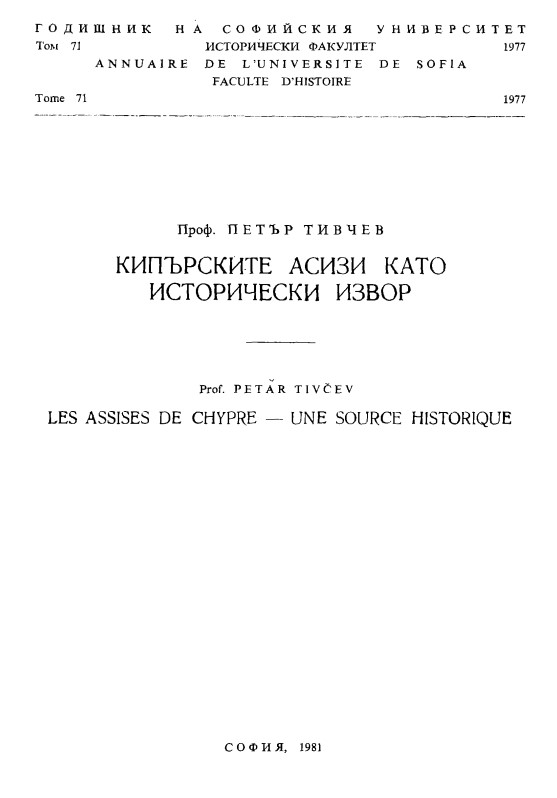The Cypriot Assisi as Historical Sources
DOI:
https://doi.org/10.60053/GSU.IF.1.71.5-84Keywords:
Cypriot traders, The struggle of the cyber merchants against the ItaliansAbstract
In the last decades of the 12th century, momentous changes occurred in the history of the island of Cyprus. As is well known, for centuries it was an integral part of the possessions of the Byzantine Empire. After falling under the rule of the Arabs for several centuries, it was reunited with Byzantium (965). During the reign of the Byzantine emperor Andronicus I Comnenus (1183-1185), one of the representatives of the Comnenus dynasty claimed the island as an independent ruler. After 1185 Cyprus was no longer joined to the empire of Constantinople. The short-lived power of Isaac Comnenus, detested by the local population, was quickly destroyed and he fell into the hands of the crusaders of the Third Crusade led by Richard I the Lionhearted. It was then briefly the property of the Knights Templar and was eventually sold to the French knight Guy de Lusignan. In 1192, the island of Cyprus became his final possession and the Kingdom of Cyprus, a western military-feudal type state, was organized there. The Greek population of Cyprus remained for a long time under the rule of the western feudal lords, who subjected it to cruel exploitation and to ethnic and religious discrimination. After 1291, with the conquest of the last possessions of the Kingdom of Jerusalem centred on Acre by the Egyptian Sultan, the royal insignia were transferred to the island of Cyprus (in the
Cyprus. Famagusta) and the ruler of Cyprus was crowned King of Jerusalem as well.
and bore the title King of Jerusalem and Cyprus.
References
L. De MasLatrie. Hisstoire de l'ile de Chypre soas lе regne des princes de lа maison de Lusignan. Т. 1. Paris, 1861, р. 2 sq.
За значението на остров Кипър в търговията с Леванта срв. W. Не у d. Histoire du commerce du Levant au Moyen age, 11. Leipzig, 1936, р. 3 - 23; А.Scе. Handelsgeschichte der romanischen Volker des Mittelalters Ьis zum Ende der Kretzzige, Miinchen - Berlin, 1906.
Срв. История на средните векове, 1 (под редакцията на С. Д. Сказкин, Е. В. Гутнова, А. И. Данилов, Я. А. Левицки). С., 1974, с. 247 - 248.
Един от най-важните извори за средновековната история на Кипър е хрониката на Леонтий Махара:
Lеоntiоs Маkhаirаs. Recital concerning the sweet Land of Cyprus entitled „Chronicle", Edited with а translation and Notes Ьу R. М. Dawkins, vol. 1-II, Oxford, 1932.
За категориите селяни срв. G. Нill. А History of Сурrus, vol. 11. The Frankish Period. Cambridge, 1972, р. 8 - 10.
За общата характеристика на Кипърското кралство и неговата структура срв. П. Тивчев, Страници от социалната история на Кипър през XIV-XVв. ИПр., г. XXVII. (1971), ки. 5, с. 22-23; За роби у П. Тивчев, Известията в хрониката на Леонтий Махера за бълrари роби на остров Кипър през втората половина на XIV в.-В: Военноисторически сборник, 1966, ки. 5, с. 39-58.
Според Сатас, Пролога, с. 55, причината да не се преведат Асизите на Високата палата била, че кръстоносците, се страхували да не се запознаят поданиците с това, че били владени като стадо.
Н. Мittеis, Zum Schuld- und Handelsrecht der Kreuzfahrerstaaten, Die Rechtsidee in der Geschichte, Gesammelte Abhandlungen und Vortгiige, 1957, р. 147.

Downloads
Published
How to Cite
Issue
Section
License
Copyright (c) 1981 Петар Тивчев

This work is licensed under a Creative Commons Attribution 4.0 International License.
Annual of Sofia University "St. Kliment Ohridski" - Faculty of History (GSU-IF).







